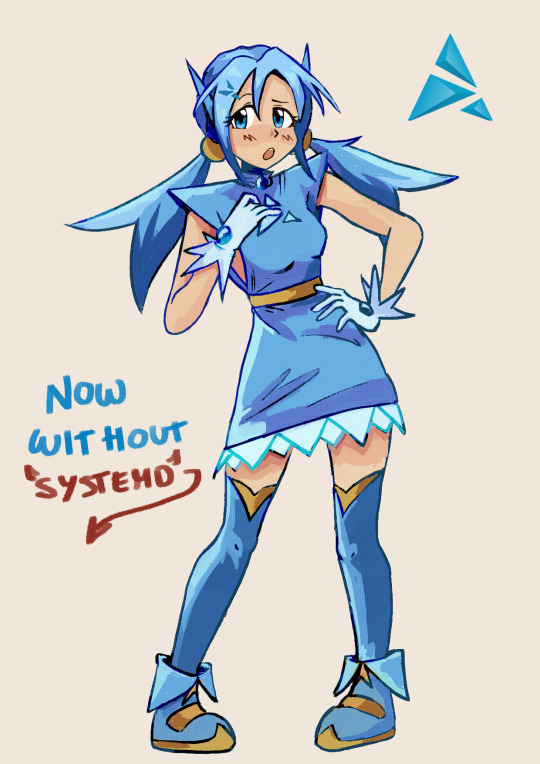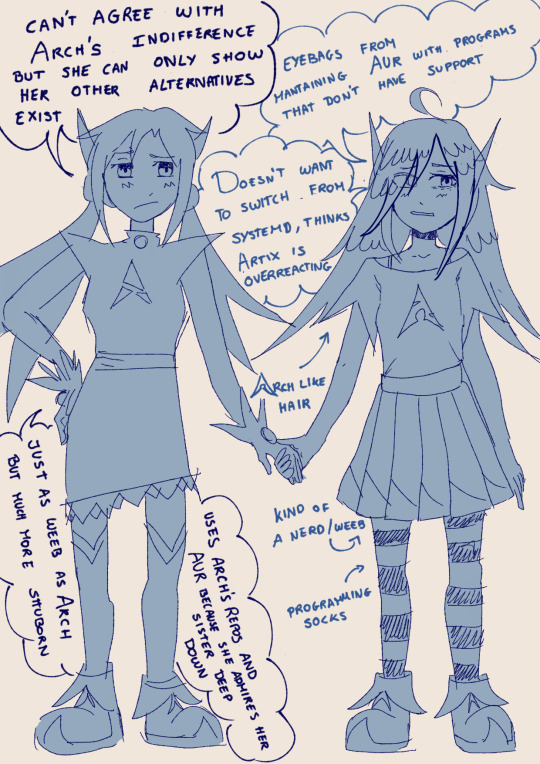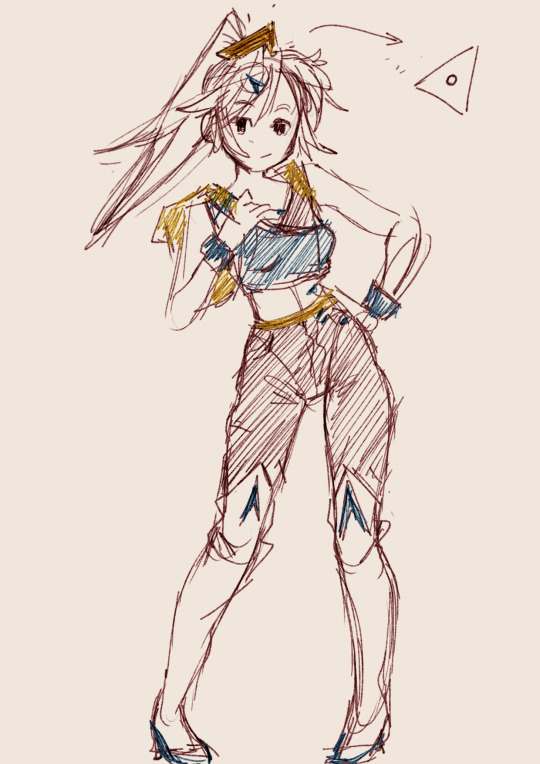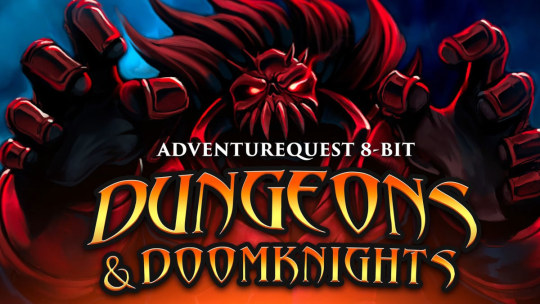#artix linux
Explore tagged Tumblr posts
Text
Artix Linux tan

A humanization of Artix Linux! As niche as this might possibly be. I also have some extras down here, I tried some designs before deciding on this one specifically. I ALSO made some funny meme™ with Arch tan (or her unfinished design more specifically) and their relationship.
Her design is mostly inspired in the logo, having triangle shapes all around the body and clothes. She is also inspired in other os-tan like Windows XP tan and so on. I wanted to make her have a "old anime aesthetic" or something. idk

In the image we have some descriptions, for those who can't read them:
On Artix-tan's side:
Cant agree with Arch's indifference but she can only show her other alternatives exist.
Just as weeb as Arch but much more sttuborn.
Uses arch's repos and AUR because she admires her sister deep down.
On Arch-tan's side:
Eyebags from mantaining AUR with programs that don't have support.
Doesn't want to switch from systemd, thinks Artix is overreacting.
Arch like hair.
Kind of a nerd/weeb.
Programming socks.
Here I have some alt design for Artix:


#os tan#artix linux#artix tan#arch tan#personification#humanization#digital drawing#digital art#robot girl#operatingsystem#arch linux#linuxposting#linux memes#linux#absolutely open source babyyyyyyy#and looking fine too#sorry for the super duper specific post I just wanted to do this ok?#ok#id in alt text#also#id in alt btw#malanArt
170 notes
·
View notes
Text

sorry arch😔 im using the openRC init system now :D I've also switched from cinnamon to xfce with no regrets. I still love cinnamon though
10 notes
·
View notes
Text








It's my Fluxbox...::

I love Fluxbox-wm so much..!
2 notes
·
View notes
Text
spent yesterday installing artix, i'm finally systemd-free
1 note
·
View note
Text

Does Artix also take out the fun part of the Arch installation? I thought I heard somewhere that there wasn’t a command line iso
Like I want to try it, but it doesn’t sound as fun if I don’t get to partition and format the drive and install my boot loader, all from the command line with no graphical system
Especially if the install environment is only available with GNOME, like some systems. Ew.
I was about to make a post complaining about the anti-systemd circlejerk brigade but then I realized that I have never actually used a non-systemd distro lmao. maybe I should give artix a go before giving my opinion
58 notes
·
View notes
Text
it's so crazy to me how windows doesn't have an equivalent of sudo like you're telling me if i want to install/upgrade/remove packages i have to run my whole ass terminal emulator with admin permissions. and if i understandably dont want it to have admin perms while i'm doing normal stuff i have to close and reopen the terminal emulator in order to de-elevate the perms.
#i have windows installed on this machine for gay ming but i am so sick of this os im gonna install artix linux on this whenever i have a#week off to get my setup just how i like it#im sure proton is fine for gaming anyway#and a lot of games have native linux support these days
5 notes
·
View notes
Text
Artix Linux: システム管理の自由を追求する systemd フリーの Arch ベースディストリビューション
Artix Linux は、Arch Linux をベースにしたローリングリリース型のディストリビューションで、特に systemd を使用しないことで知られています。代わりに、OpenRC、runit、s6 などの実績ある init システムを採用し、ユーザーに柔軟性と制御を提供します。軽量でシンプルな設計を維持しながら、安定性とセキュリティを重視しています。 Continue reading Artix Linux: システム管理の自由を追求する systemd フリーの Arch ベースディストリビューション
0 notes
Text
Take on Vampires & Ghosts with AdventureQuest 8-Bit: Dungeons & DoomKnights

AdventureQuest 8-Bit: Dungeons & DoomKnights action RPG adventure game for Linux, Mac, and Windows PC. Which is the result of the work and effort from developer Artix Entertainment. Available on Steam with Positive reviews. While having my fair share of experiences with all sorts of Linux titles. Today, I'm diving into AdventureQuest 8-Bit: Dungeons & DoomKnights, a title that's getting some attention now. Developed by Artix Entertainment and published by Nami Tentou, this release stands out as a unique blend of retro charm and humour. First off, let's talk about what sets AdventureQuest 8-Bit: Dungeons & DoomKnights apart. This title is a homage to the classic 8-bit era, reminiscent of early NES games. It’s a journey through a pixelated world brimming with a quirky mix of enemies – think vampires, ghosts, and even chicken cows. Yes, you read that right, chicken cows! It's clear that the developers aimed to sprinkle a generous dose of humor into the experience. What's appealing about em>AdventureQuest 8-Bit: Dungeons & DoomKnights is its sheer size. With over 500 screens across its Overworld and Underworld, it promises a sprawling adventure. Additionally, it includes two bonus games – "ChronoKnight" and "NecroNancy" – something you don’t often see. And for those who like to tweak their experience, there's a range of mods and visual options, including a nostalgic CRT filter.
AdventureQuest 8-Bit: Dungeon & DoomKnights Trailer
youtube
The storyline centers around Artix, a young hero on a quest to become a Paladin. The narrative kicks off with a familiar trope – returning home to find it destroyed – and propels you into a quest against an undead army. It's a simple yet effective setup that serves as the backdrop for the adventure. However, it's not all smooth sailing. AdventureQuest 8-Bit: Dungeon & DoomKnights has its quirks, and not all of them are charming. While the title starts off with a basic combat system, it evolves into a more complex style reminiscent of Metroidvania. This shift is also welcome but could have been smoother. On the flip side, the humor is a big win. The digital manual and magazine are filled with laughs, bringing a light-hearted touch to the action RPG adventure. But, it's worth noting that some elements like loot and secrets don’t quite hit the mark. So this may leave a bit to be desired. AdventureQuest 8-Bit: Dungeons & DoomKnights is a mixed bag. It's a nod to the past, packed with humor and a large world to explore, but it stumbles in some areas like gameplay depth. For those who cherish 8-bit nostalgia and a good laugh, it's worth a look. It's a journey through a pixel world that's sure to evoke memories and smiles, even if it doesn't redefine the genre. Priced at $19.99 USD / £16.75 / 19,50€ on Steam. While offering support for Linux, Mac, and Windows PC.
#adventurequest 8-bit: dungeons & doomknights#action#adventure#rpg#linux#gaming news#artix entertainmen#ubuntu#mac#windows#pc#unity#Youtube
0 notes
Text
As a transgender ThinkPad user myself, I couldn't recommend Gentoo Linux more. However, if you ever want to feel the sweet touch of grass brush against your palm again instead of waiting 12 hours for your web browser to compile, Arch Linux is your best choice. Either that, or you can use Gentoo's new binary packages, but if your not optimizing your packages for your CPU, you might as well have the benefits of using the Pacman package manager. There is a version of Arch that comes without systemd by default called Artix Linux. You might as well install that instead of regular ol' Arch to safe yourself the unnecessary bloat.
TL;DR: If you want to optimize everything for you CPU, Gentoo's Portage package manager can do just that in a crisp six weeks. If you want a distribution that is quick, lightweight, without the downsides of systemd, Artix Linux is for you.
i have like 5 years linux experience, mostly on my laptop with arch while i was in school. this install will be the first time having dual boot on my gaming pc that usually runs only windows. the install will primarily be for me to use my PC for productive things like programming and art but also movies/reading/games. it has an amd CPU and GPU if that matters.
or give suggestions i dont care
44 notes
·
View notes
Text
Artix Linux with KDE running on a librebooted Lenovo Thinkpad X200 does not shutdown from the start menu.
I read a post on here that was along the lines of “when you get better at tech, your problems don’t go away they just get weirder.”
The only reason I remember this is that I got a new (by 2008 standards) laptop and the shutdown option in the menu just doesn’t work. I looked the problem up online (using several search engines) and they ALL returned zero results.
Right now I have to shutdown the computer from the Terminal using
sudo shutdown now
It works but I’d like a more elegant solution.
I’ll try to assign the shutdown action to a keyboard shortcut and see if that works. I’ve titled the post with the phrase I tried to search for, in case this becomes the sacred texts of fixing that specific issue (not that tumblr has a functioning search, but the web crawlers might pick up on the title of the post).
1 note
·
View note
Text
Linux distros - what is the difference, which one should I choose?
Caution, VERY long post.
With more and more simmers looking into linux lately, I've been seeing the same questions over and over again: Which distro should I choose? Is distro xyz newbie-friendly? Does this program work on that distro?
So I thought I'd explain the concept of "distros" and clear some of that up.
What are the key differences between distros?
Linux distros are NOT different operating systems (they're all still linux!) and the differences between them aren't actually as big as you think.
Update philosophy: Some distros, like Ubuntu, (supposedly) focus more on stability than being up-to-date. These distros will release one big update once every year or every other year and they are thoroughly tested. However, because the updates are so huge, they inevitably tend to break stuff anyway. On the other end of the spectrum are so-called "rolling release" distros like Arch. They don't do big annual updates, but instead release smaller updates very frequently. They are what's called "bleeding edge" - if there is something new out there, they will be the first ones to get it. This can of course impact stability, but on the other hand, stuff gets improved and fixed very fast. Third, there are also "middle of the road" distros like Fedora, which kind of do... both. Fedora gets big version updates like Ubuntu, but they happen more frequently and are comparably smaller, thus being both stable and reasonably up-to-date.
Package manager: Different distros come with different package managers (APT on ubuntu, DNF on Fedora, etc.). Package managers keep track of all the installed programs on your PC and allow you to update/install/remove programs. You'll often work with the package manager in the terminal: For example, if you want to install lutris on Fedora, you'd type in "sudo dnf install lutris" ("sudo" stands for "super user do", it's the equivalent of administrator rights on Windows). Different package managers come with different pros and cons.
Core utilities and programs: 99% of distros use the same stuff in the background (you don’t even directly interact with it, e.g. background process managing). The 1% that do NOT use the same stuff are obscure distros like VoidLinux, Artix, Alpine, Gentoo, Devuan. If you are not a Linux expert, AVOID THOSE AT ALL COST.
Installation process: Some distros are easier to install than others. Arch is infamous for being a bit difficult to install, but at the same time, its documentation is unparalleled. If you have patience and good reading comprehension, installing arch would literally teach you all you ever need to know about Linux. If you want to go an easier and safer route for now, anything with an installer like Mint or Fedora would suit you better.
Community: Pick a distro with an active community and lots of good documentation! You’ll need help. If you are looking at derivatives (e.g. ZorinOS, which is based on Ubuntu which is based on Debian), ask yourself: Does this derivative give you enough benefits to potentially give up community support of the larger distro it is based on? Usually, the answer is no.
Okay, but what EDITION of this distro should I choose?
"Editions" or “spins” usually refer to variations of the same distro with different desktop environments. The three most common ones you should know are GNOME, KDE Plasma and Cinnamon.
GNOME's UI is more similar to MacOS, but not exactly the same.
KDE Plasma looks and feels a lot like Windows' UI, but with more customization options.
Cinnamon is also pretty windows-y, but more restricted in terms of customization and generally deemed to be "stuck in 2010".
Mint vs. Pop!_OS vs. Fedora
Currently, the most popular distros within the Sims community seem to be Mint and Fedora (and Pop!_OS to some extent). They are praised for being "beginner friendly". So what's the difference between them?
Both Mint and Pop!_OS are based on Ubuntu, whereas Fedora is a "standalone" upstream distro, meaning it is not based on another distro.
Personally, I recommend Fedora over Mint and Pop!_OS for several reasons. To name only a few:
I mentioned above that Ubuntu's update philosophy tends to break things once a big update rolls around every two years. Since both Mint and Pop!_OS are based on Ubuntu, they are also affected by this.
Ubuntu, Mint and Pop!_OS like to modify their stuff regularly for theming/branding purposes, but this ALSO tends to break things. It is apparently so bad that there is an initiative to stop this.
Pop!_OS uses the GNOME desktop environment, which I would not recommend if you are switching from Windows. Mint offers Cinnamon, which is visually and technically outdated (they use the x11 windowing system standard from 1984), but still beloved by a lot of people. Fedora offers the more modern KDE Plasma.
Personal observation: Most simmers I've encountered who had severe issues with setting up Linux went with an Ubuntu-based distro. There's just something about it that's fucked up, man.
And this doesn't even get into the whole Snaps vs. Flatpak controvery, but I will skip this for brevity.
Does SimPE (or any other program) work on this distro?
If it works on Fedora, then it works on Mint/Ubuntu/Arch/etc., and vice versa. This is all just a question of having the necessary dependencies installed and installing the program itself properly. Some distros may have certain prerequisites pre-installed, while others don't, but you can always just install those yourself. Like I said, different distros are NOT different operating systems. It's all still Linux and you can ultimately customize it however you want.
In short: Yeah, all Sims 2-related programs work. Yes, ReShade too. It ultimately doesn't really matter what distro you use as long as it is not part of the obscure 1% I mentioned above.
A little piece of advice
Whatever distro you end up choosing: get used to googling stuff and practice reading comprehension! There are numerous forums, discord servers and subreddits where you can ask people for help. Generally speaking, the linux community is very open to helping newbies. HOWEVER, they are not as tolerant to nagging and laziness as the Sims community tends to be. Show initiative, use google search & common sense, try things out before screaming for help and be detailed and respectful when explaining your problems. They appreciate that. Also, use the arch wiki even if you do not use Arch Linux – most of it is applicable to other distros as well.
#simming on linux#bnb.txt#if anyone wants to use this as a base for a video feel free#i don't feel like like recording and editing lol
115 notes
·
View notes
Text
Artix-tan (again)

«You still use the best distribution there is, right?»
Redid her design for no particular reason. It's almost identical, maybe a bit less extra. Anyways having kind of a "no free time whatsoever" life over here, so wish me luck.
#digital drawing#digital art#malanart#artix tan#linux#linuxposting#linux memes#computers#open source#image description in alt
19 notes
·
View notes
Text
s6 seems cool + interesting + wanna try it out bc it seems to fill in the gaps runit had for me. if u rlly can't go 5 secs w/out tryna start an init war, the tribalism button is 4 u <3
@artix-linux-official @gentoo-official @void-linux-official @arch-official @debian-official figure y'all might have insight or know folks who do
51 notes
·
View notes
Text
I just realized like yesterday that because I've lost this fedora install (long story) I no longer have this dwm config file. I have decided to deal with this by spending my Tuesday night spinning up an arch vm and creating a new dwm config file from scratch.

I would've done dwl instead but last I checked it did not play nice with VMs and even on bare metal it was a bit of a mess (even for linux standards). I probably will not use this on production again though because x11 sux.

finally trying out dwm, the final boss of linux.
#x11 isn't that bad i just really like having vrr for gaming#dwm linux#linux#window managers#arch btw#i used archinstall lol#i did do the full arch install process once when i put artix on a spare computer for funsies but i couldn't be arsed to do it again
8 notes
·
View notes
Text
so i'm trying to use rhythmbox to put some songs onto an old ipod mini but the songs don't show up (even after formatting the playlist to .m3u). anyone else have advice on this or should i just get a normal music player?
#itunes is not an option because i run artix linux#wanted to play around with having an offline backup of music#linux#apple#ipod mini#itunes#mp3 players#open source
2 notes
·
View notes
Note
should i put gentoo on the new framework? i’m breaking up with ubuntu for sure, i don’t know if i want to move back in with arch while systemd is still living there, but i’ve been warned about gentoo… but i feel like i should try it, for completeness
If you do, you should show the framework running gentoo. That's something I haven't seen before, it'd be pretty neat.
But i'd be remiss if I didn't point out, if you want Arch but don't want SystemD, @artix-linux-official is right there, and she can handle OpenRC pretty well.
Don't get me wrong, I'd be honored to be your distro of choice. But I don't feel right being someone's break-up distro.
14 notes
·
View notes